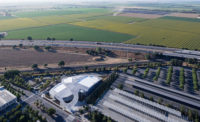Each year, a fresh crop of art museums spring up in large cities and far-flung places alike. While it is hard to compete with the attention those oftentimes flashy new buildings garner, older institutions rely on their greatest asset to keep the public interested—their incomparable collections—adding on or revamping their historic buildings’ interiors to better display these works.
Spanning 250 years of history and encompassing more than three million objects, the Hermitage Museum in St. Petersburg, Russia, is among the world’s most renowned repositories for art and culture. The opening in June of a new satellite location in a 17th-century building in Amsterdam, the Netherlands, brings the Hermitage’s unique splendor to a much wider audience.
Amsterdam-based firm Merkx + Girod Architects updated the interiors of the former nursing home, transforming its main halls into bright, contemporary galleries. “This was a classical Dutch building that asked for a clear and sober design approach,” explains Evelyne Merkx. But for temporary features, the architects did refer to the Baroque style of the museum’s St. Petersburg buildings. In their design for the opening exhibition, At the Russian Court, outline graphics in both gold foil and white-on-white relief depict those buildings’ facades at full scale on the galleries’ walls. Adds Merkx, “The interior design makes use of contemporary materials and forms without historicizing.”
Two venerable North American institutions—the Art Gallery of Ontario (AGO) and the Art Institute of Chicago (AIC)—recently unveiled dramatic additions to their own historic buildings [record, August 2009, pages 52 and 66]. Nestled within Frank Gehry’s striking face-lift of Toronto’s AGO, Shim-Sutcliffe Architects created a courtyardlike space to display the Frum Collection of African Art. Designed as a room within a room, a perimeter gallery wraps the luminous inner space, where etched-glass walls provide an ethereal backdrop for the large sculptural objects displayed on a central oak plinth inside. “There is a sense of interiority and of being outside at the same time,” says Brigitte Shim. Smaller objects rest within the perimeter walls’ vertical slot windows, allowing viewing on both sides while providing a visual connection between the inner and outer galleries. “We created portals so that visitors could catch glimpses of the interior gallery from the perimeter,” explains Shim.
The construction of Renzo Piano’s Modern Wing at the AIC permitted an extensive reshuffling of the galleries within its older buildings, particularly inside the landmark Beaux-Arts structure along Chicago’s Michigan Avenue. Kulapat Yantrasast of Los Angeles–based wHY Architecture likens his firm’s interior upgrades of the AIC to acupuncture. “Instead of adding, ours is an architecture of intervention in an old building,” he says. “We focused on key areas to rejuvenate the whole body.”
As part of the overhaul, wHY sought to create interactive layouts that would engage visitors. “We wanted to produce vistas and moments of discovery,” says Yantrasast. “We were matchmakers in a way, choreographing the relationship between person and object.”
One of the first galleries to reopen, Prints and Drawings was transformed from a long, narrow corridor into a series of rooms where visitors could circulate. While galleries that display delicate works on paper are typically darker, wHY focused light on the floors rather than on the works themselves, creating a bright, flexible space.
For the European Decorative Arts galleries, wHY dispensed with the period rooms the museum previously used to exhibit such works, designing instead a contemporary space whose freestanding walls offer views across cultures and centuries. “We respected the scale and proportions of the historic building,” Yantrasast says, “but offered a cleaner, more modern aesthetic.”
The Metropolitan Museum of Art is the largest in the U.S. despite being confined to its current footprint in New York City’s Central Park. But ongoing upgrades have kept visitors coming in droves. Most recently, the Charles Engelhard Court reopened following a two-year renovation by Kevin Roche John Dinkeloo and Associates [Read an interview with Kevin Roche and American Wing chairman Morrison Heckscher] that injected the grand entrance to the museum’s American Wing with a new lightness and vibrancy.
The glass-enclosed pavilion was conceived over 30 years ago as a gardenlike leisure space planted with trees and flowers. “In the intervening years, we learned that trees and flowers do not flourish there,” admits Morrison Heckscher, chairman of the American Wing. “We determined that our first priority must be the proper display of our unparalleled collections of American sculpture, stained glass, and other decorative arts.”
A glazed elevator directs visitors to the refurbished period rooms, and glass parapets open up the balcony galleries to view from below, where a limestone floor replaces dark brick pavers and planters. The new design puts the art front and center, where it belongs.





